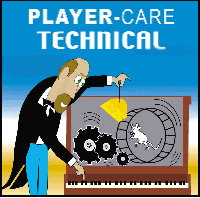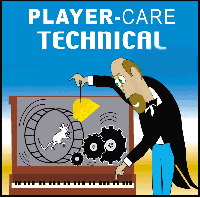
|

|

|

|

|

|
| Home | Manuals | Supplies | Search | Consult | Contact | Testing | Service |


|
Rebuilding Schultz Valve Pneumatics
By Bob and Sonja Lemon
We have rebuilt a couple of Schultz actions with great success. There
are a few tricks to doing a good rebuild of the valves and pouch
pneumatics, which we will explain here.
1. Be sure to measure the width of the material. Too narrow and it
will limit valve travel. Too much and the pneumatics bind on one
another. We have covered the pneumatics with both leather and Schultz
cloth. The cloth is much easier to use. Be sure to notice that the
hinge end of the pneumatic "floats" and has a binding strip to capture
the hinge end.
2. Also note the lead weights in the moveable board. If the lead
weights have started to corrode, they have probable split the moveable
pneumatic board, if so you will have to make a new set of boards with
new weights. This can be quite a challenge! We obtained some new
heavy weight sheet lead material from a local sheet metal shop from
which we cut the weights. Try to match the weights as close as
possible with the original and completely coat the lead with thick
shellac before placing in the pneumatic. This serves a two fold
purpose: as glue and sealant.
3. Since the pneumatics are SO small, and hard to handle, we devised a
fixture to hold the pneumatic boards while recovering 3 sides. We used
a piece of 1 1/2" x 3 1/2" x 1/2" thick phenolic. Close to one end we
cut a "V" shaped hole ( \_/ ), equal to the size of the fully opened
pneumatic. Allow about 1/16" extension of the pneumatic boards beyond
the edge of the fixture (for ease of gluing). One side of the "V" is
notched to allow room for the bleed cup. Drill a hole through the long
side of the fixture into the space between the pneumatic boards.
Through the hole run a small diameter shaft (bolt). On the pneumatic
side there is a "V" shaped wedge attached to the shaft. The maximum
width of the wedge is slightly less than the pneumatic boards. On the
other end of the shaft, outside the fixture, a spring is captured with a
couple of lock nuts. To use this fixture, the two pneumatic boards are
put in place, the wedge is pushed toward the open end of the pneumatic,
rotated 90 degrees and allowed to be pulled back by the spring, thus
locking the boards tightly in place. You can now proceed to cover the
open end and both sides with the pouch cloth, using hot hide glue.
After the glue is set, again push in the wedge, twist 90 degrees and
remove the pneumatic. Complete large groups of pneumatics before you
glue the hinge end.
[ "Ascii-art", display with mono font such as Courier. -- Robbie ]
_ ___
________________\\ ___ / /__ ---- pneumatic boards
| \\/ W \/ / | ---- wedge
| \\_|_/ / |
| \\|/__/ | ---- phenolic block
|____________________|________|
|
| ---- shaft with spring
|
0 ---- Nuts!
Note: The wedge must be able to slip through the opening in the hinge
end of the pneumatic. (I sure hope this transfers okay! This is my
first effort at e-mail graphics! -- Sonja )
4. After the hinge end is closed and trimmed, gentle blow into the
pneumatic to make the butterfly while collapsing the pneumatic. The
hinge end should be folded in and the other 3 sides fold out.
Carefully glue the retaining strap to the hinge end with the pneumatic
closed. Be sure to observe the allowance on the deck for this
retaining strap. This is important!
5. Before removing pneumatics and valve covers, check the opening
distances of the pneumatics with the valves in both positions. This
information is critical to the later setting of valve hooks.
We'll stop here for now. When you get this far, let us know, and we'll
instruct for the next steps.
Bob & Sonja Lemon
|

![]() ..To
The Top of this Page . . . . . . . . . . .
..To
The Top of this Page . . . . . . . . . . . ![]() ..To The HOME Page
..To The HOME Page
|
Since "Player-Care" is an internet business, I prefer that we correspond via E-Mail (click here to fill out the 'Request Form'). However, if I'm not in the middle of some other activity, you can reach me at 732-840-8787. But please understand that during the hours from 8AM-5PM EST (Mon-Sat), I'm generally quite busy. So, I probably won't answer the phone. If you get the answering machine, please leave a detailed message stating the reason for your call. Also, repeat your name and phone number clearly and distinctly. By necessity, I prioritize everything in my life. And, if you call and just leave your name and number, and ask me to call you back, it might be a day or two before I return your call. Why? Because I don't know why you want me to call and I might not be prepared to assist you in an effective and efficient manner. If you leave me an E-Mail address (which I prefer), spell it out phonetically. The more you do to help me, the more I can help you in return. Don't rush. You have four minutes to record your message. |
|
407 19th Ave, Brick, NJ, 08724 Phone Number 732-840-8787 (Voicemail Only, No Texts) |
